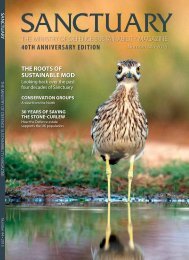SUSTAINABILITY
UBUt5
UBUt5
You also want an ePaper? Increase the reach of your titles
YUMPU automatically turns print PDFs into web optimized ePapers that Google loves.
FEATURES<br />
30 years of saving stone-curlews<br />
fortunes of these ‘goggle eyed plovers’.<br />
For 30 years, RSPB field workers have<br />
been locating nests and marking<br />
them so they can be avoided by<br />
machinery, and where necessary,<br />
carefully lifting clutches of chicks out<br />
of harm’s way and returning them after<br />
operations have finished – what we<br />
call ‘interventions’. This partnership<br />
includes working with the MOD to<br />
ensure that all of the land it manages<br />
is in optimum condition for stonecurlews:<br />
creating new plots, carrying<br />
out plot management during the<br />
breeding season, integrating with<br />
military training, and encouraging<br />
grazing for foraging stone-curlews<br />
near their nests.<br />
Stone-curlew © David Kjaer<br />
Stone-curlews are very shy and secretive birds, and nest on<br />
extensive open habitats of heath and grassland, so it is no<br />
surprise that military sites have been their sanctuary.<br />
Stone-curlew nest in no more than a<br />
shallow scrape on the ground and lay<br />
two hen-sized speckled eggs. Eight<br />
military sites support between 40-45%<br />
of the UK stone-curlew population,<br />
and have played a crucial role in saving<br />
this beguiling bird from near extinction<br />
in the UK.<br />
Historically stone-curlews would<br />
have nested directly on grass heaths,<br />
downland or fallowed land where<br />
the vegetation was closely cropped<br />
by rabbits and sheep or sparse from<br />
cultivation. The species declined<br />
at least from the 1930s when<br />
agricultural intensification resulted<br />
in crops and trees being planted<br />
on grass heaths and downland.<br />
Consequently, stone-curlews had to<br />
nest more readily on land prepared<br />
for spring crops, where nests<br />
were inadver tently destroyed by<br />
machiner y, and the population fell<br />
from perhaps 1000 -2000 pairs in the<br />
post war period to around 150 pairs<br />
in the mid 1980s.<br />
Because of the loss of suitable<br />
breeding sites and the threat to nests<br />
on cultivated land, special nesting<br />
plots were developed as part of the<br />
wider conservation management.<br />
The MOD has prepared these as<br />
part of their Sites of Special Scientific<br />
Interest (SSSI) programmes while agrienvironment<br />
schemes have supported<br />
these measures on private farmland.<br />
Here birds can nest without risk of nest<br />
loss from agricultural management.<br />
The loss of extensive semi-natural<br />
grassland happened across the<br />
breeding range of the stone-curlew,<br />
but on many of the MOD sites this<br />
grassland remained. These areas were<br />
considered so important for a range<br />
of species that many of them have<br />
been given formal designated status<br />
as protected areas under National and<br />
European legislation.<br />
In 1985, a partnership between<br />
landowners and conservationists<br />
began, which has turned around the<br />
As a result of these successful<br />
conser vation measures, the stonecurlew<br />
population increased back<br />
to around 350 pairs nationally, and<br />
in 2009 stone-curlews were offcially<br />
downgraded from Red to Amber<br />
conservation concern, in the revised<br />
Population Status of Birds in the UK.<br />
The Stanford Training Area (STANTA) is<br />
situated in the ‘Brecks’ on the border<br />
of Norfolk and Suffolk. The Stanford<br />
Training Area SSSI is approximately<br />
4,500ha and contains approximately<br />
half of the remaining grass heath<br />
habitat within the Brecks. Hard<br />
grazing and physical disturbance<br />
are an essential part of grass heath<br />
management, as this provides the<br />
short turf and bare ground which<br />
priority Breck species, including stonecurlew,<br />
require.<br />
Since 2000 the MOD have managed<br />
17 specially created plots to create this<br />
bare ground habitat, however, from 2015<br />
onwards, an additional 110 plots will be<br />
created and managed to increase the<br />
extent of this important habitat.<br />
It is anticipated that this work will<br />
benefit up to 454 priority invertebrate<br />
species, which will be closely<br />
monitored by a PhD project. It is still<br />
early days, but stone-curlew have<br />
54<br />
Sanctuary 44 • 2015



